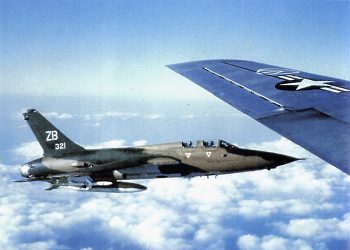
"THUD 71" SEEN HERE IN THE SKIES OVER VIETNAM SHOWING THE "ZULU BRAVO" TAILCODE OF THE 6010th WILD WEASEL SQUADRON FLYING OUT OF KORAT RTAFB, THAILAND
 "THUD 71" SEEN HERE IN THE SKIES OVER VIETNAM SHOWING THE "ZULU BRAVO" TAILCODE OF THE 6010th WILD WEASEL SQUADRON FLYING OUT OF KORAT RTAFB, THAILAND |
A number of F-105F models were converted to the F-105G antiaircraft suppression configuration and designated "Wild Weasel." Pilots flying Wild Weasel missions were tasked with the most hazardous duty of all, attracting the attention of the air-defense sites and then launching missiles to destroy the enemy's radar systems.
The F-105G was fitted with improved avionics and advanced electronic countermeasures (ECM) and radar homing and warning (RHAW) systems that allowed Wild Weasel crews to engage enemy air defense systems with devastating effectiveness. RHAW systems for the F-105G included the AN/APR-35, AN/APR-36, AN/APR-37, and AN/ALR-31. Installation of the AN/ALR-31 required redesign of the wingtips to accommodate a pair of antennas. Additionally, the F-105G was fitted with an Itek Radar Direction Finding and Homing system and a Bendix APS-107 target acquisition system. Most F-105G aircraft were also equipped with a combat camera mounted underneath the nose just behind the radome. The F-105G was also equipped with Westinghouse AN/ALQ-105 self-protection jammers that were faired into the sides of the lower fuselage. This allowed additional ordnance to be carried on the wing pylons.
 |
In 1967, the first F-105G Wild Weasels were assigned to the 357th Tactical Fighter Squadron of the 355th Tactical Fighter Wing based at Tahkli Royal Thai Air Force Base in Thailand. F-105G, serial no. 63-8321 was assigned to 17th Wild Weasel Squadron of the 388th TFW at Korat RTAFB. Late in the war, the airplane may have been reassigned to Detachment 1 of the 561st TFS when it deployed to Korat. During its time in Southeast Asia, 63-8321 was variously nicknamed "Sawadee Krud" and "Miss Lucky" by its crews.
Following the U.S. withdrawal from Vietnam, two F-105G squadrons (the 561st TFS and 562nd TFS) returned to Tactical Air Command's 35th TFW at George AFB, California. In 1975, 63-8321 was assigned to the 562nd TFS. By 1978, it had been reassigned to the 561st TFS.
|
|
